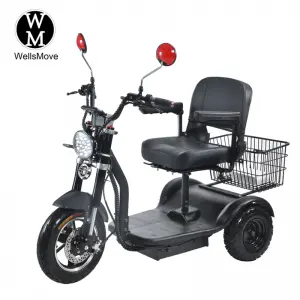Mobility scooters have become an essential tool for people with limited mobility, providing new freedom and independence. From running errands to navigating crowded spaces, these devices are designed to adapt to a variety of environments and improve the user’s quality of life. However, one important aspect of an electric scooter that is often overlooked is its turning radius. In this blog, we’ll delve into the importance of a good turning radius and guide you in choosing the ideal mobility scooter for your specific needs.
Know the turning radius
Before we evaluate what a good turning radius is, let’s define the term itself. Turning radius refers to the amount of space a mobility scooter requires to complete a 360-degree turn. A smaller turning radius means you can maneuver in tight spaces, reducing the need for wide turns and making it easier to maneuver through congested areas.
The importance of a good turning radius
Imagine needing to make a U-turn in a narrow corridor or walk through a crowded shopping mall. A mobility scooter with a tight turning radius may not provide you with the agility you need in this situation, leading to frustration and limited accessibility. A good turning radius ensures you can quickly change direction, avoid obstacles, and perform precise maneuvers, providing a safer and more efficient user experience.
Determine the ideal turning radius
Now that we understand the importance of a good turning radius, it’s crucial to determine the ideal measurement for your specific needs. Mobility scooters typically range from smaller, more compact models to larger, heavy-duty alternatives. While everyone’s requirements may vary, there are some general guidelines to consider.
1. Compact mobility scooter
If you primarily use your scooter indoors or have limited space to move around, a compact might be your best option. The turning radius of these scooters typically ranges from 30 to 35 inches, allowing you to maneuver through tight corners, tight hallways, and doorways with ease. Their reduced size allows for easy maneuvering in limited spaces, making them ideal for indoor mobility.
2. Medium-sized mobility scooter
Midsize mobility scooters strike a balance between portability and enhanced stability. These versatile models have a turning radius of 40 to 45 inches and are suitable for indoor and outdoor use. They offer excellent maneuverability while offering increased stability and comfort thanks to a stronger frame and wider seat options.
3. Heavy duty scooter
Heavy-duty mobility scooters are designed for rough terrain and extended outdoor use, and have a larger turning radius than smaller mobility scooters. Its sturdy construction enhances durability and stability, ensuring a smooth ride in challenging environments. Heavy-duty scooters typically have a turning radius between 50 and 55 inches, providing adequate maneuverability while handling uneven surfaces and higher weight capacity.
personal considerations
While these guidelines provide a general understanding of the turning radius of different types of mobility scooters, it’s important to consider your specific requirements. Here are some other factors to keep in mind:
1. Personal Space: Assess the areas you browse frequently, such as your home, work, or favorite shopping area. Measure hallways, doorways, and tight corners to determine the minimum turning radius your scooter needs to comfortably maneuver through these spaces.
2. Outdoor use: If you plan to use your mobility scooter mainly outdoors, it is recommended to choose a model with a larger turning radius. This will allow you to more easily maneuver on uneven terrain and handle potential obstacles such as curbs or uneven pavement.
3. User comfort: When choosing a mobility scooter, always consider your own comfort and ease of use. Test different models to find the right balance between turning radius and stability to ensure a smooth and enjoyable ride.
A good turning radius is critical in determining a mobility scooter’s ability to adapt to various environments and meet your specific needs. By understanding the importance of turning radius and considering factors such as personal space, outdoor use and user comfort, you can confidently choose a mobility scooter that combines agility and stability, ultimately enhancing your independence and mobility. Remember, everyone’s requirements are unique, so take the time to find the perfect balance between turning radius and personalized comfort. Happy skating!
Post time: Nov-24-2023



